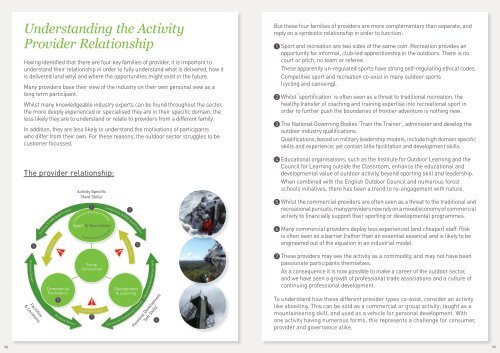outdoors-participation-report-v2
outdoors-participation-report-v2
outdoors-participation-report-v2
Create successful ePaper yourself
Turn your PDF publications into a flip-book with our unique Google optimized e-Paper software.
Understanding the Activity<br />
Provider Relationship<br />
Having identified that there are four key families of provider, it is important to<br />
understand their relationship in order to fully understand what is delivered, how it<br />
is delivered (and why) and where the opportunities might exist in the future.<br />
Many providers base their view of the industry on their own personal view as a<br />
long term participant.<br />
Whilst many knowledgeable industry experts can be found throughout the sector,<br />
the more deeply experienced or specialised they are in their specific domain, the<br />
less likely they are to understand or relate to providers from a different family.<br />
In addition, they are less likely to understand the motivations of participants<br />
who differ from their own. For these reasons, the outdoor sector struggles to be<br />
customer focussed.<br />
The provider relationship:<br />
Revenue Stream<br />
6<br />
Facilities<br />
& Locations<br />
Training & NGB Qualification<br />
Regulation<br />
Commercial<br />
Facilitation<br />
5<br />
Revenue Stream<br />
Activity Specific<br />
‘Hard Skills’<br />
1<br />
Competition • Coaching • Training<br />
Sport & Recreation<br />
Positively Informal Activity<br />
Social<br />
Connection<br />
Commodification<br />
7<br />
Leadership & NGB Qualification<br />
3<br />
Sportification<br />
2<br />
Development<br />
& Learning<br />
Educational Development Skills<br />
Commercial Development Training<br />
4<br />
Personal Development<br />
‘Soft Skills’<br />
But these four families of providers are more complementary than separate, and<br />
reply on a symbiotic relationship in order to function:<br />
1 Sport and recreation are two sides of the same coin. Recreation provides an<br />
opportunity for informal, club-led apprenticeship in the <strong>outdoors</strong>. There is no<br />
court or pitch; no team or referee.<br />
These apparently un-regulated sports have strong self-regulating ethical codes.<br />
Competitive sport and recreation co-exist in many outdoor sports<br />
(cycling and canoeing).<br />
2 Whilst ‘sportification’ is often seen as a threat to traditional recreation, the<br />
healthy transfer of coaching and training expertise into recreational sport in<br />
order to further push the boundaries of frontier adventure is nothing new.<br />
3 The National Governing Bodies ‘Train the Trainer’, administer and develop the<br />
outdoor industry qualifications.<br />
Qualifications, based on military leadership models, include high domain specific<br />
skills and experience; yet contain little facilitation and development skills.<br />
4 Educational organisations, such as the Institute for Outdoor Learning and the<br />
Council for Learning outside the Classroom, enhance the educational and<br />
developmental value of outdoor activity, beyond sporting skill and leadership.<br />
When combined with the English Outdoor Council and numerous forest<br />
schools initiatives, there has been a trend to re-engagement with nature.<br />
5 Whilst the commercial providers are often seen as a threat to the traditional and<br />
recreational pursuits, many providers now rely on a mixed economy of commercial<br />
activity to financially support their sporting or developmental programmes.<br />
6 Many commercial providers deploy less experienced (and cheaper) staff. Risk<br />
is often seen as a barrier (rather than an essential essence) and is likely to be<br />
engineered out of the equation in an industrial model.<br />
7 These providers may see the activity as a commodity, and may not have been<br />
passionate participants themselves.<br />
As a consequence it is now possible to make a career of the outdoor sector,<br />
and we have seen a growth of professional trade associations and a culture of<br />
continuing professional development.<br />
To understand how these different provider types co-exist, consider an activity<br />
like abseiling. This can be sold as a commercial or group activity; taught as a<br />
mountaineering skill; and used as a vehicle for personal development. With<br />
one activity having numerous forms, this represents a challenge for consumer,<br />
provider and governance alike.<br />
98 99


